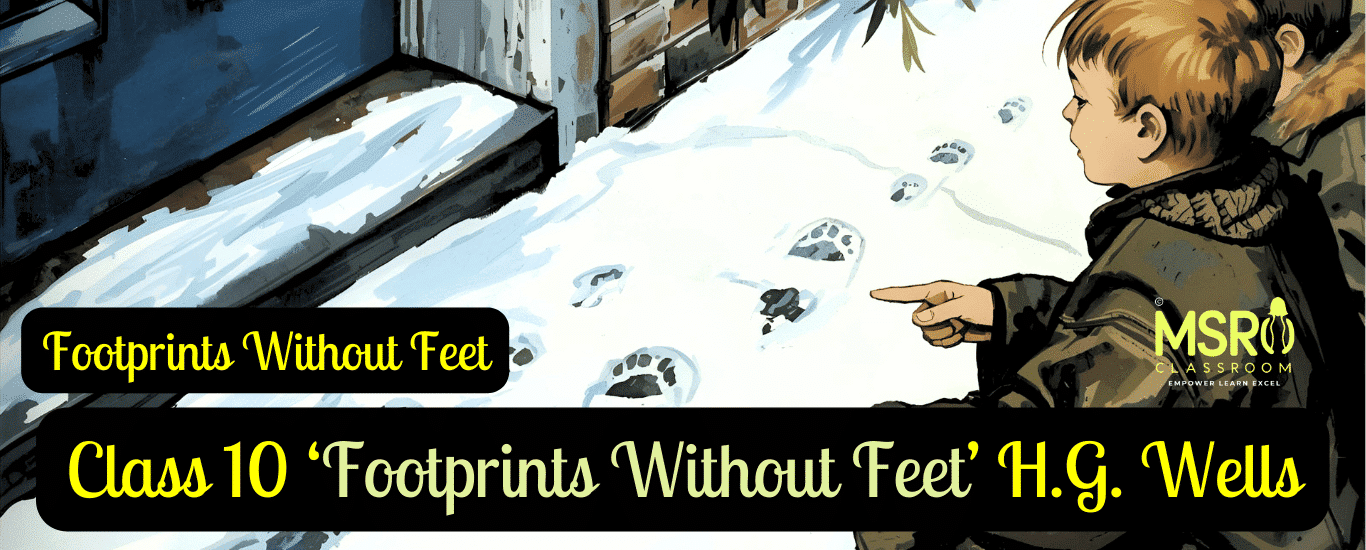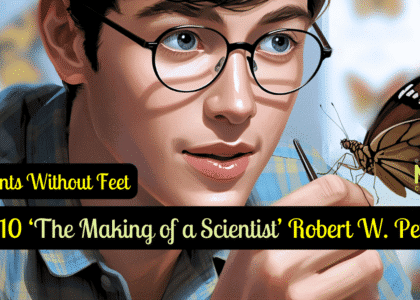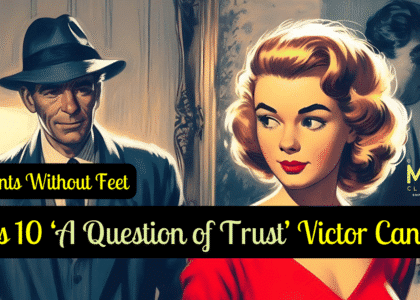Chapter 5, H.G. Wells’ ‘Footprints Without Feet’ Summary, Theme, Character Sketch, Important Passages, Question Answers with Extra Questions.
Chapter 5- Footprints Without Feet by H.G. Wells:
Table of Contents
More from Class 10– Class 10- PROSE, Class 10- POETRY
Vocabulary:
| Imprints: Marks or impressions made by pressure, in this context, the marks left by bare feet. Eject: To force or throw something out. Wanderer: A person who travels aimlessly without a fixed course or destination. Chase: To pursue catching up with or catching up with. Callously: Showing or having an insensitive and cruel disregard for others. Solitude: The state of being alone, often by choice. Eccentric: Unconventional and slightly strange behaviour or appearance. Bewildered: Perplexed and confused; very puzzled. Hysterics: A wildly emotional and exaggerated reaction. Witchcraft: The practice of magical skills, spells, and abilities. |
Idiomatic expressions used in the story “Footprints Without Feet” by H.G. Wells:
| Set all tongues wagging: To cause people to start talking excitedly or gossiping. Made every effort to be friendly: Trying very hard to be kind and pleasant. Extraordinary affair: An unusual or remarkable event or situation. Rose up against me : To rebel or act hostile toward someone. Strongly suspected of: Believed with a high degree of certainty that someone is responsible for something. Shook himself free: Managed to escape or get loose from someone’s grasp. Knocked unconscious: Strike someone so that they become unconscious. |
‘Footprints Without Feet’ by H.G. Wells blends satire with allegorical elements. While the story has elements of humour, especially in the absurd situations caused by Griffin’s invisibility and the reactions of others, its primary focus is on using these elements to convey social commentary and philosophical questions.
Satire: The story satirises human nature and societal norms through the character of Griffin, who uses his invisibility to commit crimes and escape consequences. It critiques issues like scientific ethics, moral decay, and the consequences of unchecked power.
Allegory: Griffin’s invisibility is an allegory for human behaviour and society’s unseen or hidden aspects. It metaphorically explores themes of transparency, moral invisibility, and the consequences of scientific advancement.
Summary ‘Footprints Without Feet’:
In H.G. Wells’ “Footprints Without Feet,” two boys discover mysterious footprints in London. They follow them to find Griffin, a scientist who can make himself invisible. Griffin, facing challenges like cold weather and financial troubles, causes chaos in the village inn where he stays.
Suspected of theft and accused of witchcraft, he reveals his invisibility to the villagers, leading to a chaotic attempt at his arrest. Ultimately, Griffin escapes, leaving behind a tale of invisibility and societal consequences.
Explanation of ‘Footprints Without Feet’ for Auditory Learners:
Duration: 10 minutes
English subtitles. Concise, Exam-Focused, with Visual Cues. Perfect for Learning and Revision.
Theme of ‘Footprints Without Feet’:
Boons and Perils of Scientific Knowledge:
The theme of H.G. Wells‘ “Footprints Without Feet” revolves around the misuse of scientific knowledge and its consequences. Griffin, a brilliant but reckless scientist, discovers how to make himself invisible. Instead of using this power for good, he engages in theft and violence, causing fear and chaos.
His actions highlight the dangers of using scientific advancements irresponsibly. The story also explores themes of isolation and the moral implications of one’s choices. Griffin’s invisibility, intended as a scientific triumph, ultimately leads to his downfall, showing that power without ethics can result in personal and societal harm.
More in the video explanation.
Character Sketch of Griffin:
Griffin: The Lawless Invisible Scientist
1. Appearance:
- Invisible form: Entirely transparent, invisible to the naked eye.
- Disguise: Bandages on his face, dark glasses, false nose, whiskers, large hat.
2. Personality:
- Brilliant: Exceptional scientist with groundbreaking discoveries.
- Lawless: Disregards moral and legal boundaries.
- Vindictive: Sets fire to his landlord’s house out of spite.
- Secretive: Avoids interaction and seeks solitude.
- Irritable: Easily angered, quick-tempered.
- Desperate: Steals and resorts to violence when needed.
3. Actions and Behaviour:
- Innovative: He develops a method to become invisible.
- Reckless: Uses invisibility irresponsibly, leading to chaos.
- Resourceful: Finds ways to survive (stealing clothes, food, money).
- Manipulative: Deceives people to avoid detection.
- Evasive: Escapes capture by exploiting his invisibility.
- Aggressive: Attacks shopkeeper and constable to secure escape.
4. Motivations:
- Scientific Curiosity: Driven by a desire to push scientific boundaries.
- Revenge: Takes drastic actions against those who wrong him.
- Survival: Uses any means necessary to stay alive and hidden.
5. Consequences:
- Isolation: His invisibility leads to social and physical isolation.
- Conflict: Creates turmoil wherever he goes.
- Downfall: His unethical use of science leads to his eventual downfall.
Question Answers ‘Footprints Without Feet’ by H.G. Wells:
Comprehension Questions:
Q1: How did the invisible man first become visible?
A1: The invisible man, Griffin, first became visible when he accidentally stepped in the mud while fleeing his burning house. The mud left visible footprints, making him briefly seen by others.
Q2: Why was he wandering the streets?
A2: Griffin was wandering the streets because he had become homeless after setting fire to his landlord’s house in revenge. He was also invisible due to a scientific experiment gone awry.
Q3: Why does Mrs Hall find the scientist eccentric?
A3: Mrs. Hall finds the scientist eccentric because he is secretive and quick-tempered and causes unusual disturbances in her inn. His invisible presence and mysterious behaviour make him appear strange to her.
Q4: What curious episode occurs in the study?
A4: In the study of a clergyman’s house, a curious episode occurs when noises awaken the clergyman and his wife. Despite finding no one in the room, they discover that the money on the desk has been stolen.
Q5: What other extraordinary things happen at the inn?
A5: At the inn, other extraordinary things happen when objects in Griffin’s room seem to move independently, such as a hat hitting Mrs Hall’s face and a chair appearing to attack her. These incidents fuel rumours of supernatural activity linked to Griffin’s invisible presence.
Think About It:
Q1: “Griffin was rather a lawless person.” Comment.
A1: Griffin’s character in the story is depicted as rebellious and disregarding laws and societal norms. His actions, such as setting fire to his landlord’s house and stealing to survive, reflect his lawlessness.
His lack of moral restraint overshadows Griffin’s scientific brilliance. He uses his invisibility for personal gain and revenge without considering the consequences for others. His disregard for authority and tendency to cause chaos make him a figure of intrigue and fear in the story.
Q2: How would you assess Griffin as a scientist?
A2: Griffin demonstrates remarkable scientific ingenuity in discovering how to make his body invisible, which showcases his intellect and dedication to experimentation.
However, his unethical behaviour and misuse of his discovery tarnish his credibility as a scientist. His actions suggest a focus more on personal power and freedom than on advancing knowledge for the benefit of society.
Regardless of his scientific achievements, Griffin’s lack of ethical conduct and disregard for the well-being of others diminish his reputation as a responsible scientist, leaving a legacy of fear and suspicion rather than admiration for his scientific prowess.
Talk About It:
Q1: Would you like to become invisible? What advantages and disadvantages do you foresee, if you did?
A1: As tempting as it might seem to become invisible, there are advantages and disadvantages to consider. On the positive side, invisibility could allow me to move around unnoticed, which could help me avoid unwanted attention or explore without interference. It also helps in situations where privacy or secrecy is important.
However, being invisible could also have drawbacks. It might lead to loneliness or isolation if others can’t see or interact with me. There could be ethical dilemmas, such as the temptation to misuse invisibility for personal gain or harm.
Invisibility might also make it difficult to communicate or build relationships effectively. While it offers potential benefits, it also brings significant challenges and responsibilities that need careful consideration.
Q2: Are there forces around us that are invisible, for example, magnetism? Are there aspects of matter that are ‘invisible’ or not visible to the naked eye? What would the world be like if you could see such forces or such aspects of matter?
A2: Yes, forces and aspects of matter are invisible to the naked eye. For example, magnetism is a force that we cannot see directly, but we can observe its effects on objects like magnets and metals.
Similarly, some aspects of matter, such as atoms and molecules, are too small to be seen without specialised equipment like microscopes.
If we could see these invisible forces and aspects of matter, the world would be different. We would have a deeper understanding of how things work fundamentally. It could lead to discoveries in science and technology, potentially revolutionising fields like medicine, materials science, and energy. However, it also changes our perception of the world, making us more aware of the complexities and interconnectedness of everything around us.
Q3: What makes glass or water transparent (what is the scientific explanation for this)? Do you think it would be scientifically possible for a man to become invisible, or transparent? (Keep in mind that writers of science fiction have often turned out to be prophetic in their imagination!)
A3: Glass and water are transparent because their molecular structure allows light to pass through them without significant absorption or scattering. In scientific terms, transparency is related to the arrangement of atoms and molecules in these materials, which determines how light interacts with them.
Researchers are studying concepts like metamaterials and cloaking devices that could manipulate light around an object, making it appear invisible. While achieving true invisibility remains challenging due to the complexity of light manipulation and the human body’s biological processes, scientific advancements continue to push boundaries.
Science fiction writers have often inspired and sometimes even anticipated scientific developments, so while complete invisibility might not be achievable, future breakthroughs could bring us closer to this imaginative concept.
Extra Questions ‘Footprints Without Feet’ by H.G. Wells:
Short Answer Type Questions:
Q1: What prompted the boys’ surprise at the story’s start?
A1: The boys were surprised to see fresh, muddy footprints of bare feet on the steps of a house in London, but no one was around. They were amazed when more footprints appeared from nowhere and followed them until they disappeared.
Q2: How did Griffin manage to become invisible?
A2: Griffin became invisible by experimenting with rare drugs that made his body as clear as glass. Even though his body was transparent, it remained solid. This discovery allowed him to move unseen, but he faced many challenges.
Q3: Why did Griffin set fire to his landlord’s house?
A3: Griffin set fire to his landlord’s house because the landlord disliked him and tried to evict him. In revenge, Griffin used his invisibility to escape without being seen, leaving him without clothes, money, and a place to stay.
Q4: How did Griffin disguise himself after escaping the London store?
A4: After escaping the London store, Griffin disguised himself at a theatrical shop. He wrapped bandages around his head and wore dark glasses, a false nose, big side whiskers, and a large hat. The disguise made him look like an average person and hid his invisibility.
Q5: Why did the clergyman and his wife suspect Griffin of burglary?
A5: The clergyman and his wife suspected Griffin of burglary because they heard noises and saw money taken from the clergyman’s desk early in the morning. When they checked the room, it was empty, but the money was gone. They later learned about Griffin’s strange behaviour and invisible abilities.
Q6: How did Griffin cause chaos in Mrs. Hall’s inn room?
A6: Griffin caused chaos in Mrs. Hall’s inn room by using his invisibility to move objects. He made the hat fly at Mrs. Hall, and a chair seemed to attack her and her husband. The room appeared haunted, scaring them and making them believe supernatural forces were at work.
Q7: Why did Mrs Hall believe her furniture was haunted?
A7: Mrs Hall believed her furniture was haunted because she witnessed strange and seemingly supernatural events in Griffin’s room. Objects moved independently, such as a hat flying and a chair seemingly attacking her. These events and Griffin’s invisible presence convinced her that spirits or ghosts were responsible for the disturbances.
Q8: What was the villagers’ initial explanation for the strange occurrences at the inn?
A8: The villagers initially explained the strange occurrences at the inn as witchcraft or supernatural phenomena. They believed that Griffin, the mysterious stranger staying at the inn, was responsible for the bizarre events involving the furniture. This suspicion grew as more unusual incidents happened, contributing to their fear and confusion.
Q9: How did Griffin reveal his invisibility to the villagers?
A9: Griffin suddenly reveals his invisibility to the villagers by removing his disguises. He discards his bandages, glasses, false nose, and whiskers in front of them, shocking them with his headless appearance. This abrupt revelation confirms their suspicions about his strange abilities and adds to his mystery.
Q10: What happened when the constable attempted to arrest Griffin?
A10: When the constable attempted to arrest Griffin, chaos ensued. Griffin, using his invisibility, resisted arrest by shedding his clothes, making it impossible for the constable to grasp him. Unseen blows struck others who tried to help. Ultimately, Griffin escaped, leaving everyone bewildered and unable to capture him.
Long Answer Type Questions:
Q1: How did discovering invisibility change how Griffin acted and dealt with people?
A1: Discovering invisibility altered Griffin’s behaviour and interactions with others. Initially driven by scientific curiosity, Griffin’s newfound ability made him feel superior and detached from societal norms. He became secretive, using invisibility for personal gain and to evade consequences.
It led him to commit theft and burglary without fear of detection. His invisibility also isolated him, as he struggled to connect emotionally with people due to his unique condition. Moreover, it fueled paranoia and aggression, causing him to lash out against anyone who threatened his secrecy.
Invisibility changed Griffin from a curious scientist into a desperate and morally compromised individual, alienating him from society and leading to his eventual downfall.
Q2: How did being invisible help and complicate Griffin’s crimes in the story?
A2: Being invisible helped Griffin commit crimes by allowing him to move undetected and escape capture. He could enter places unnoticed, steal goods, and evade authorities easily. For instance, he stole clothes and food from stores and eluded capture by shedding his visible clothing.
However, his invisibility also complicated his crimes. It isolated him from society, making it challenging for him to interact normally and obtain necessities like food and shelter without theft. Moreover, his invisibility aroused suspicion and fear, leading to accusations and misunderstandings, such as being blamed for supernatural events.
Ultimately, while invisibility facilitated his criminal activities, it also exacerbated his isolation and descent into desperation and violence, contributing to his tragic downfall in the story.
Q3: How did Griffin’s first experiments with invisibility show his personality and moral limits?
A3: Griffin’s initial experiments with invisibility revealed facets of his personality and ethical boundaries. His pursuit stemmed from scientific curiosity but also hinted at disregarding ethical considerations.
He was willing to risk his own well-being and sanity to achieve invisibility, indicating a single-minded determination and perhaps a lack of concern for consequences. His decision to use invisibility for personal gain—such as theft and evasion—demonstrated moral ambiguity and a willingness to exploit his newfound power.
This shows that Griffin possessed intellect and ambition, but his ethical compass was skewed. It led him down a path where scientific discovery blurred with selfish pursuits, ultimately defining his descent into isolation and criminal behaviour throughout the story.
Q4: How did the people in Iping react to Griffin’s presence, and why did they think strange things were happening because of him?
A4: The people of Iping reacted with curiosity, suspicion, and fear to Griffin’s presence. His strange appearance and secretive behaviour immediately made him different, arousing their curiosity.
When peculiar events occurred—such as furniture moving on its own and mysterious noises—they attributed these occurrences to Griffin. His invisibility, unknown to them, compounded their suspicions, leading them to believe he was involved in supernatural activities or witchcraft. This fear was fueled by their inability to explain the phenomena logically, creating a sense of unease and mistrust towards Griffin.
Thus, his odd behaviour and the unexplained events contributed to the villagers’ belief that Griffin was responsible for the strange happenings in their community.
Q5: How did Griffin’s need to stay secret affect what he wore and how he dealt with Mrs Hall and the constable?
A5: Griffin’s need to remain invisible dictated his choice of clothing and interactions with others. He wore bandages, glasses, a false nose, and other disguises obtained from a theatrical shop to conceal his transparent state. The attire hid his lack of physical features and helped him avoid suspicion.
In his dealings with Mrs Hall, Griffin maintained a secretive and aloof demeanour, refusing to engage socially to protect his identity. When confronted by the constable, his invisibility fueled paranoia, causing him to resist arrest by shedding his visible clothing, making capture difficult.
These actions highlighted Griffin’s desperation to maintain secrecy, shaping his interactions as cautious and defensive, driven solely by the need to preserve his invisibility and evade detection.
Q6: Analyse the theme of isolation in the story and its connection to Griffin’s pursuit of invisibility and his eventual downfall.
A6: The theme of isolation is central to Griffin’s story and is closely tied to his pursuit of invisibility. As Griffin becomes invisible, he also becomes increasingly isolated from society.
His invisibility separates him physically and emotionally from others, making it impossible for him to interact normally. This isolation intensifies his loneliness and desperation, driving him to criminal behaviour and further alienating him from those around him. Griffin’s inability to connect with people leads to paranoia and a sense of persecution, causing him to lash out violently.
His isolation ultimately contributes to his downfall, as his desperate actions make him a target of fear and hostility. The story illustrates how Griffin’s quest for invisibility, intended to empower him, traps him in a cycle of isolation and self-destruction.
Q7: Discuss the symbolism of Griffin’s invisibility and its parallels with themes of power, identity, and moral decay in H.G. Wells’ narrative.
A7: Griffin’s invisibility symbolises the dangerous allure of unchecked power and the loss of identity. By becoming invisible, Griffin gains immense power but loses his physical presence, representing a loss of personal identity and connection to humanity.
The power tempts him to commit immoral acts, revealing his ethical decay. His invisibility allows him to act without consequences, leading to criminal behaviour and violence. The more he relies on his invisibility, the more he isolates himself, showcasing the corrupting influence of absolute power.
H.G. Wells uses Griffin’s invisibility to explore how pursuing power can erode one’s morals and identity, ultimately leading to self-destruction. Griffin’s tragic end highlights the perils of losing humanity in the quest for dominance.
Q8: How did Griffin’s interactions with the clergyman and Mrs. Hall highlight the contrast between his scientific pursuits and his disregard for societal norms?
A8: Griffin’s interactions with the clergyman and Mrs. Hall highlight the contrast between his scientific ambitions and his neglect of social norms. With the clergyman, Griffin’s invisibility allows him to commit theft, disregarding moral and legal standards. The theft reveals how his scientific achievement has led him to prioritise his needs over ethical conduct.
Similarly, with Mrs Hall, Griffin’s secretive and rude behaviour shows his lack of respect for social customs and hospitality. His refusal to explain himself or engage kindly with her emphasises his focus on maintaining his invisibility at any cost.
These interactions underscore how Griffin’s pursuit of scientific discovery has distanced him from societal expectations, leading him to act selfishly and unethically, ultimately contributing to his downfall.
Q9: Evaluate Griffin’s descent into paranoia and violence as his invisibility became both a tool for survival and a catalyst for his downfall.
A9: Griffin’s invisibility, initially a tool for survival, gradually leads him into paranoia and violence. He becomes increasingly isolated and distrustful of others as he uses his invisibility to steal and escape capture.
The isolation fuels his paranoia, making him feel constantly threatened and alone. His fear and desperation cause him to react violently, lashing out at anyone who challenges or confronts him. These actions further alienate him from society and escalate his sense of persecution.
Griffin’s descent into violence and madness demonstrates how his invisibility, meant to give him power, instead traps him in a cycle of fear and aggression. Ultimately, his inability to trust others or control his violent impulses leads to his downfall.
Q10: What insights does the story offer into the ethical dilemmas posed by scientific advancement, especially concerning invisibility and its consequences?
A10: The story offers essential insights into the ethical dilemmas of scientific advancement, especially invisibility. It shows that scientific discoveries, while powerful, can have unintended and harmful consequences if misused.
Griffin’s invisibility gives him incredible power but also leads him to commit crimes and harm others, highlighting the potential for abuse. His actions reveal the dangers of pursuing knowledge without considering moral responsibilities. The story warns that advancements can isolate individuals from society and corrupt their values.
It emphasises the need for ethical guidelines and caution in scientific research to prevent adverse outcomes. It teaches that scientific progress should be balanced with ethical considerations to ensure it benefits humanity rather than causing harm.
Important Passages from ‘Footprints Without Feet’ by H.G. Wells:
1. Introduction of the footprints and Griffin’s invisibility:
- “The two boys started in surprise at the fresh muddy imprints of a pair of bare feet. What was a barefooted man doing on the steps of a house, in the middle of London? And where was the man?”
- “The bewildered boys had been following a scientist who had just discovered how to make the human body transparent.”
| Context: The opening passages introduce a scientist named Griffin, who has discovered a method to become invisible. The story starts with two boys noticing fresh footprints of a barefoot man in London, leading them to realise that this man, Griffin, has made himself invisible using his scientific discovery. This sets the stage for the mysterious and adventurous events that follow in the story. |
2. Griffin’s lawlessness:
“His landlord disliked him and tried to eject him. In revenge Griffin set fire to the house…until he happened to step in some mud, and left footprints as he walked!”
- Griffin, a scientist, becomes invisible through a scientific experiment. When his landlord tries to evict him and sets the house on fire in retaliation, he is forced to flee without clothes. The mud reveals his footprints, briefly making him visible. This sets the stage for his invisible escapades, where he faces the challenges of being visible and clothed.
(Griffin’s stay in a store) “Closing time arrived, and as soon as the doors were… He broke open boxes and wrappers and fitted himself out with warm clothes.”
- After becoming invisible, Griffin uses a store closing to dress and feed himself without paying. He opens boxes and helps himself, enjoying luxury at no cost until morning workers discover him.
(Griffin’s escape from the store) “If only Griffin had managed to wake up in good time all might have been well. … So once more he found himself invisible but naked in the chill January air.”
- Griffin oversleeps and is discovered by morning staff. Panicking, he runs away but becomes visible and naked due to his tardiness. He faces cold weather and difficulties in avoiding detection.
(Griffin’s theft from a theatrical shop) “This time he decided to try the stock of a theatrical company…attacked the shopkeeper from behind, after which he robbed him of all the money he could find.”
- Seeking disguise, Griffin robs a theatrical shop. He dons various items, including bandages, glasses, a fake nose, side whiskers, and a hat to hide his invisibility. He robs the shopkeeper and escapes, continuing his journey.
(The incident at the clergyman’s house) “Shortly afterwards, a curious episode occurred. Very early in the morning …Yet the desk had been opened and the housekeeping money was missing.”
- Griffin steals money from a clergyman’s desk, leaving the clergyman and his wife bewildered. They cannot see anyone in the room despite hearing noises and finding their money missing.
| Context: These events portray Griffin’s misuse of his invisibility discovery for criminal acts, driven by revenge and necessity. Despite his scientific brilliance, he becomes a fugitive, causing fear and suspicion wherever he goes. His ability to manipulate invisibility leads to increasingly audacious thefts and escapades, complicating his interactions and leading to a growing pursuit by authorities and civilians alike. |
3. The strange happenings at the inn:
“The landlord and his wife were up very early, and were surprised to see the scientist’s door wide open…Springing into the air it charged straight at her, legs foremost.”
- These events suggest that Griffin, who was invisible, was causing mischief in the inn. Although no one could see him, his presence was indicated by the strange movements of objects around the room. This incident made the landlord and his wife believe that the room might be haunted or that some supernatural force was at play.
| Context: Griffin’s invisibility allows him to manipulate objects without being seen, creating confusion and fear among the inn’s owners. This incident marks a turning point where Griffin’s actions become increasingly disruptive and noticeable, leading to heightened tension and suspicion in the village. |
4. Griffin’s confrontation with Mrs. Hall and the constable:
“The scientist was always quick-tempered; now he became furious…In the end Jaffers was knocked unconscious as he made a last attempt to hold on to the unseen scientist.”
- Griffin, known for his quick temper, becomes very angry when Mrs. Hall accuses him of causing disturbances with her furniture. In a rage, he suddenly removes his disguises: bandages, false whiskers, glasses, and a fake nose.
- Griffin’s ability to become invisible and manipulate his appearance adds to the fear and suspicion surrounding him. His actions, especially when revealed startlingly, make people believe he possesses supernatural abilities or is involved in dark magic.
| Context: Griffin’s confrontation with Mrs. Hall and Mr. Jaffers showcases his invisibility’s disruptive and alarming nature. His quick temper and ability to change his appearance unexpectedly create chaos and confusion, further complicating efforts to apprehend him and adding to the mystery surrounding his actions. |





